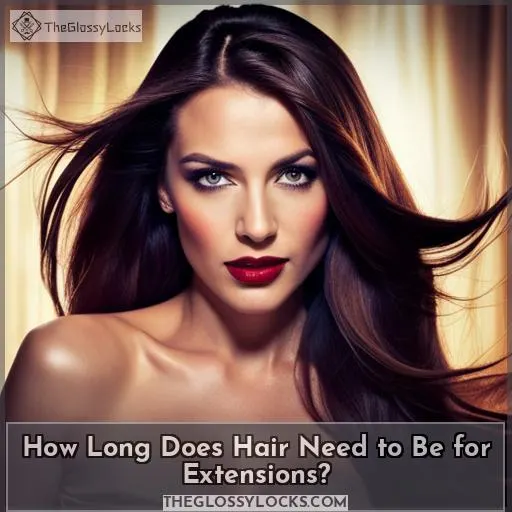This site is supported by our readers. We may earn a commission, at no cost to you, if you purchase through links.
 Imagine having the luscious, flowing locks you’ve always dreamed of. But first, you need to know: how long does your hair have to be for extensions?
Imagine having the luscious, flowing locks you’ve always dreamed of. But first, you need to know: how long does your hair have to be for extensions?
Don’t worry – we’ve got all the answers for you! In this article, we’ll explore the minimum lengths required for different types of extensions like stick-on, fusion and tape-in.
Whether you’re aiming for added length or volume, we’ll help guide you towards finding the perfect extensions that will make your hair dreams a reality.
So let’s dive in and discover how to achieve that gorgeous mane!
Table Of Contents
Hair Length for Extensions
To ensure a successful and seamless application of extensions, it’s important to consider the minimum hair length required for each type.
- Stick-on extensions typically require a minimum hair length of 14 inches.
- Fusion and tape-in extensions need at least 8 inches.
- For track weft extensions, one inch of hair length is sufficient.
Matching your natural hair length with the appropriate extension type will help achieve a natural-looking result without compromising on security or comfort.
Minimum Length for Stick-on Extensions
To apply stick-on extensions, your hair needs to be at least 14 inches long.
Stick-on extensions offer compatibility for shorter hair lengths and provide a convenient option for those seeking instant length and volume.
The application process involves attaching the adhesive strips to your natural hair, ensuring a secure hold throughout the day.
Maintenance is relatively simple with stick-on extensions, allowing you various styling options while maintaining their seamless blend with your own hair.
Minimum Length for Fusion and Tape-in Extensions
If you’re considering fusion and tape-in extensions, your hair needs to be at least 8 inches (20 centimeters) long.
These extension types require a minimum hair length for proper attachment and blending.
Fusion extensions involve bonding individual strands of extensions to your natural hair, while tape-in extensions use adhesive wefts applied close to the scalp.
The minimum length requirement ensures secure application and seamless integration with your own locks.
Minimum Length for Track Weft Extensions
You need at least one inch (2.5 centimeters) of hair length for track weft extensions to be applied.
- Track weft extensions are suitable for shorter hair lengths.
- Hair texture and type play a role in determining if track wefts will blend seamlessly.
- Matching your natural hair length with the extension type ensures a natural look.
Considering Your Hair Type
When considering getting hair extensions, it’s important to take your hair type into account.
Wefted tape-in and fusion extensions require consideration of your hair’s thickness and length, as the rule of thumb is that the hair used for these extensions should be thicker than your own.
Stick-on extensions, on the other hand, don’t depend on your natural texture or thickness; glue holds them securely in place.
The choice of extension type should align with your natural characteristics to ensure a seamless blend and secure attachment.
Thickness and Length Considerations for Wefted Tape-in and Fusion Extensions
When considering wefted tape-in and fusion extensions, it’s important to assess the thickness and length of your own hair.
The compatibility of these extensions with your hair type will determine how well they blend and hold in place.
It’s recommended that the hair used for these extensions be thicker than your natural hair to ensure a seamless look.
Additionally, assessing the quality of both your natural hair and potential extensions is essential for achieving satisfactory results.
Texture and Thickness Considerations for Stick-on Extensions
Consider your natural hair type and texture when determining the suitability of stick-on extensions.
- Texture matching is crucial for a seamless blend with your own hair.
- Thickness consideration ensures that the extensions enhance rather than overpower your natural locks.
- Attachment methods like glue should be compatible with your specific hair type to avoid damage or discomfort.
Consulting a professional hair extension specialist can help you make informed decisions based on these factors.
Importance of Hair Quality
When it comes to hair extensions, the quality of the hair is crucial for achieving natural-looking and long-lasting results.
Good quality extensions are made from uncolored and unpermed hair, as chemical treatments can damage both your natural hair and contaminate the extensions.
It’s important to preserve the texture and health of your own hair by avoiding harsh treatments before getting extensions.
By prioritizing high-quality, untreated hair, you can ensure better outcomes with your extension experience.
Avoiding Chemically Treated Hair
Maintaining the integrity of your extensions is crucial by prioritizing the avoidance of chemically treated hair.
Chemically treated hair can negatively impact the quality and lifespan of your extensions. It’s important to assess hair quality before getting extensions, as chemical treatments like coloring or perming can damage both natural hair and contaminate the extensions.
By opting for unprocessed, virgin hair, you ensure better results with your extensions and reduce maintenance costs in the long run.
Assessing Texture and Quality Before Ordering Extensions
Before ordering extensions, it’s important to assess the texture and quality of your own hair.
Texture assessment allows you to determine compatibility with different extension types.
Evaluating the quality ensures that you choose virgin hair, free from chemical treatments that can impact its durability and color.
By requesting a sample of virgin hair from a reputable hair extension salon, you can make an informed decision based on firsthand knowledge of its texture and overall quality for successful short hair extension transformations.
Wash and Maintenance Levels
When it comes to wash and maintenance levels for tape-in extensions, proper care is crucial.
Using the right shampoo, conditioner, and hair treatments is essential in keeping both your natural hair and extensions healthy.
It’s important to consider the level of commitment you’re willing to put into maintaining your extensions before choosing this type of extension method.
Care and Maintenance Requirements for Tape-in Extensions
To properly care for tape-in extensions and ensure their longevity, you need to be diligent in maintaining the wash and maintenance levels.
Tape-in extension care involves using gentle shampoos and conditioners specifically designed for extensions.
Avoiding excessive heat styling, brushing gently from roots to ends, and keeping hair tangle-free are all essential steps in extending the lifespan of your tape extensions.
Additionally, regular visits to a professional stylist can help maintain proper placement and prevent potential damage.
Proper Use of Shampoo, Conditioner, and Hair Treatments
When caring for your tape-in extensions, it’s important to use:
- Shampoo
- Conditioner
- Hair treatments
These products are formulated to maintain the quality of both your natural hair and the extensions themselves. By following a proper hair care routine with extension-specific products, you can ensure that your extensions stay in good condition and last longer.
This won’t only save you money on replacements but also give you beautiful, natural-looking hair that exudes confidence and power.
Consideration of Cost
When considering hair extensions, it’s important to factor in the cost as an investment.
While high-quality extensions may come with a higher price tag upfront, they can save you money in the long run by reducing the need for regular haircuts and styling products.
It’s essential to consult with experts who can guide you through different extension types and help you find options that align with your budget while still providing long-term benefits and savings.
Investment in High-quality Extensions
Investing in high-quality extensions is crucial when considering the cost of hair extensions.
While they may come with a higher price tag, these extensions offer long-term savings by reducing the need for regular haircuts.
It’s important to consult with experts to explore different extension types such as clip-in, track weft, micro ring, and micro bond extensions.
By balancing the cost of extensions with their long-term benefits and budget considerations, you can make an informed decision that suits your desired results and financial situation.
Balancing Cost With Long-term Benefits and Savings
As you consider the cost of hair extensions, it’s important to balance this expense with the long-term benefits and savings they can provide.
Budget planning is crucial in making an extension investment that aligns with your financial balance.
While high-quality extensions may come at a higher upfront cost, they can save you money in the long run by reducing frequent visits to the salon for haircuts or styling.
Consider how extensions can contribute to your long-term savings and overall hair transformation goals.
Conclusion
Achieving the luscious, flowing locks of your dreams is possible with the right extensions.
Stick-on extensions typically require a minimum hair length, while fusion and tape-in extensions can work with shorter hair.
Track weft extensions also have their own minimum length requirements.
By understanding the specific length requirements for each type of extension, you can choose the option that best suits your hair goals.
So, get ready to transform your hair and make your dreams a reality with the perfect extensions for you!








